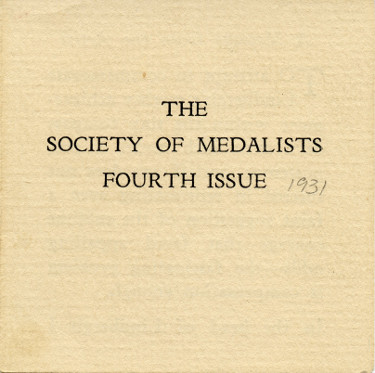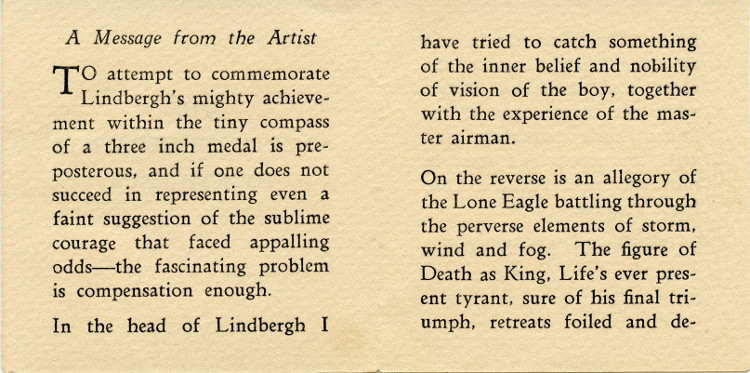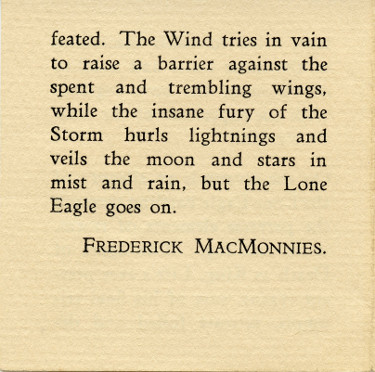The John E. Marqusee Collection [201 - 250]
This page contains the fifth fifty medals listed in the John E. Marqusee Collection catalogue. The catalogue, authored by Susan Luftschein, is a wonderful resource for the American Art Medal collector and includes much beyond the simple list of medals. These pages simply attempt to provide a web-searchable repository for medals that are not all shown in the printed edition.
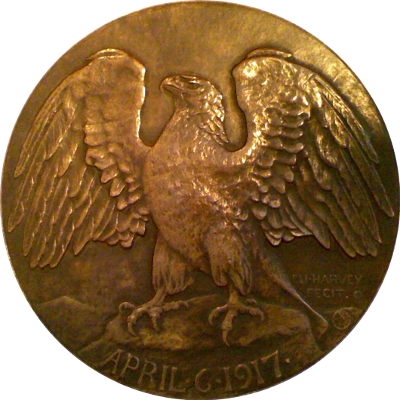
This is the 31st official issue of the American Numismatic Society.
The obverse bears martial American Eagle, perched on crag, wings spread threateningly. Below, APRIL - 6 - 1917; signed in lower right, ELI HARVEY / FECIT. ©; American Numismatic Society oak leaves in circle beneath signature.
The edge is marked MEDALLIC ART CO. N.Y. and stamped with the number 42.
This medal was issued by the American Numismatic Society to commemorate the United States' entrance into World War I. After publicly striving to keep the United States neutral, President Woodrow Wilson finally asked Congress for a "war to end all wars" that would "make the world safe for democracy". Congress formally declared war on Germany on April 6, 1917.
A bronze medallion of the eagle was sent to Pershing's field headquarters in France by the medal commissioners. Mr. Harvey didn't know it. In a note under the photograph of the medal found in Harvey's personal collection, he wrote:
"One day I found a letter in the vestibule mailbox addressed to Mrs. Harvey (my first wife Mary) from the general. I asked if she had written to General Pershing and she said yes. 'Why didn't you tell me?' I asked. 'Because I knew thee would say, don't bother the general now, he has charge of two million American boys.' I agreed."
General Pershing, who had made a specialty of studying these birds, liked it very much.
The medal measures 88.9mm in diameter and was struck by the Medallic Art Company of New York. The reported mintage is 1 piece in gold, 50 in silver and 113 pieces in bronze.
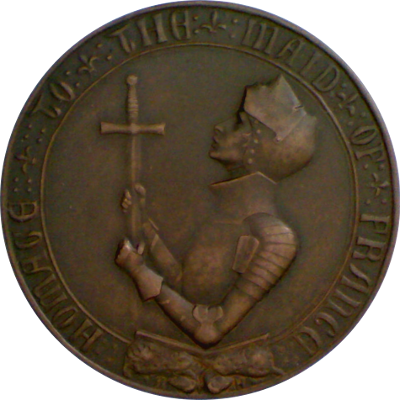
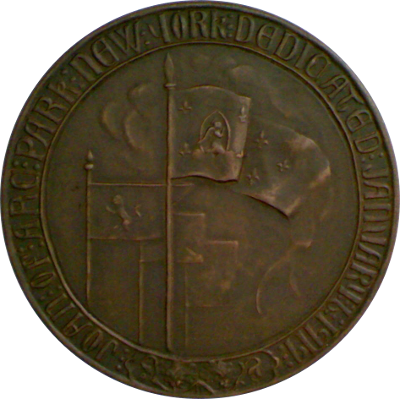
This medal was the 39th issue of the American Numismatic Society.
The obverse bears portrait of Joan of Arc in armor facing left, holding sword hilt up like a cross, face raised in prayer or contemplation. Around, :: HOMAGE ::+:: TO :+: THE :+: MAID :+: OF :+: FRANCE ::; signed at bottom, A - H
The reverse displays gothic banner of Joan of Arc with other pennants fluttering behind. Around, JOAN OF ARC PARK DEDICATED JANUARY 6, 1919.
Miss Hyatt was chosen by the ANS to execte this beautiful and sensitive medal because she had created the distinctive statue of Joan of Arc on Riverside Drive, overlooking the Hudson River. The Vatican canonized Joan of Arc in the same year, therefore the medal was doubly appropriate and not just representative of the park dedication ceremony.
The medal measures 65mm in diameter and was struck by the Medallic Art Company of New York. The reported mintage is 1 piece in gold, 74 pieces in silver, 119 pieces in bronze and 1 piece in lead.
References: Marqusee 206
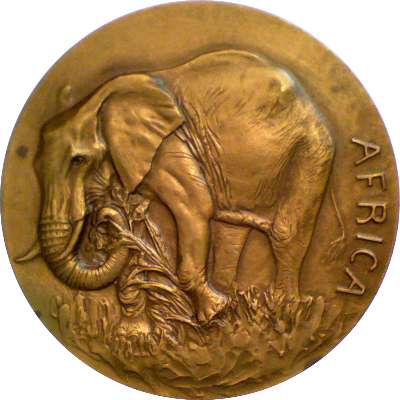
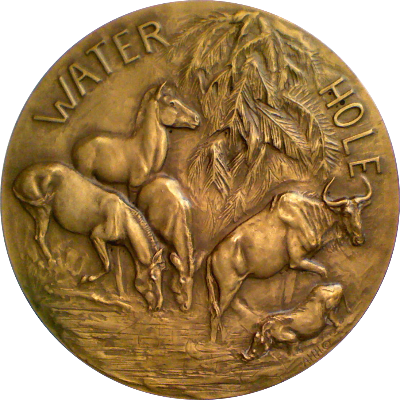
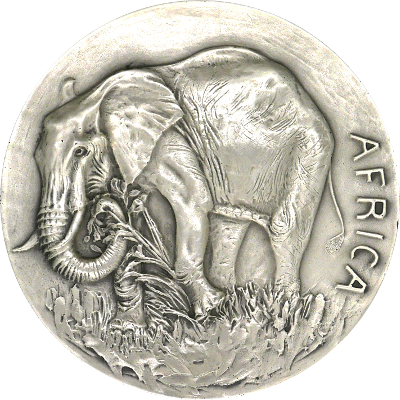
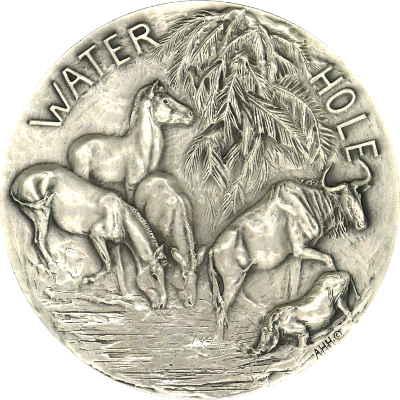
This medal was chosen as the 27th issue of the prestigious Society of Medalists series in 1943. The obverse bears elephant feeding on sapling gripped in its trunk. To right, AFRICA
The reverse bears water hole with zebras and warthog drinking, gnu walking away at right. Above, WATER HOLE; at lower right, A.H.H. ©
Huntington had already achieved fame for her equestrian and animal sculptures when she completed this medal for the Society of Medalists. She picked an animal wildlife subject and executed it beautifully.
This medal measures 73mm in diameter and was produced by the Medallic Art Company of New York which struck 747 pieces in bronze and 100 in silver.
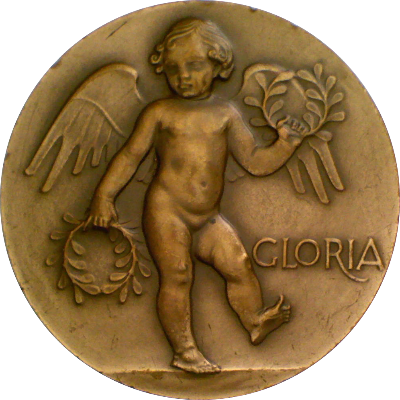
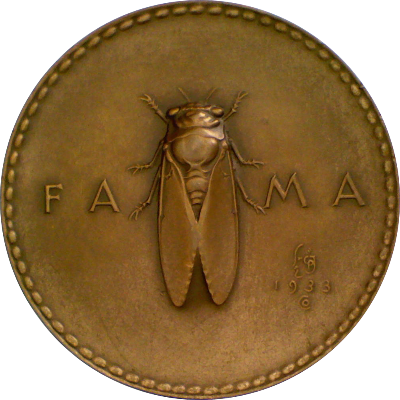
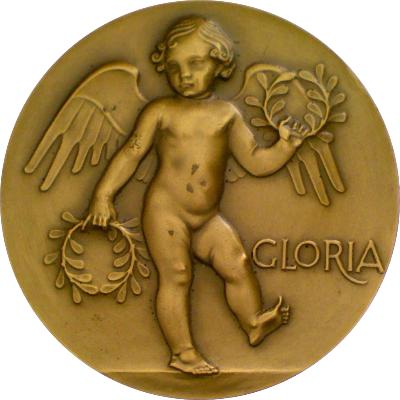
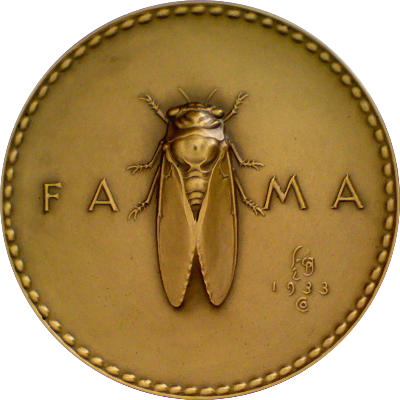
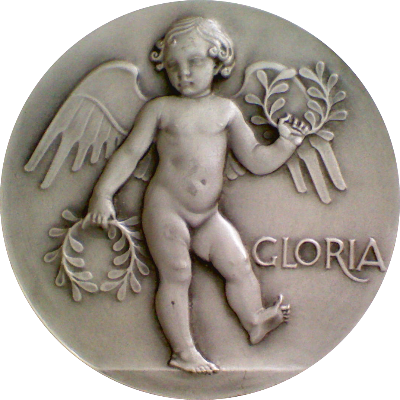
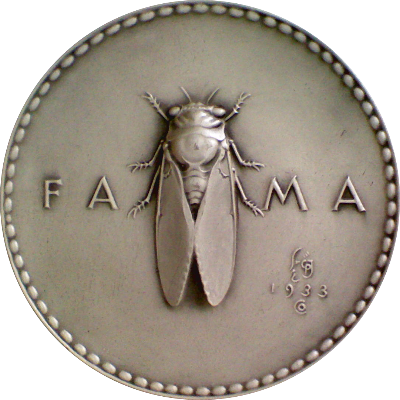
This medal was chosen as the 7th issue of the prestigious Society of Medalists series. The medal's obverse bears a winged cherub holding two laurel crowns. At lower right, GLORIA. The reverse bears a cicada flanked by FA - MA; in lower right Jennewein's distinctive signature, a stylized facial profile, CPJ / 1933 / ©. The border is boldly beaded.
Jennewein contrasts Glory and Fame, two aspects of achievement and recognition, on a medal, which itself is often used as an award. He thus makes a subtle point not just about the distinction between fame and glory but also about the medium itself. In his "Message from the Artist" Jennewein wrote:
"Fame and Glory are symbolized in this medal as the elements in the life of men which the awarding of medals is designed to promote and recognize. But the artist has made a subtle distinction between that Glory which, unsought, belongs to those who aspire, strive and sacrifice for a great ideal, and that Fame which is won by self-seeking in the attainment of public eminence for the gratification of personal power and vanity."
He used the cicada as a symbol for the latter because its "noisy and shrill self-assertion gains wide hearing but is only the discordant demonstration of an obstreperous but insignificant creature." If Jennewein was annoyed by this type of person, I wonder what he would make of much of modern pop culture...
The medal measures 73mm in diameter. The Medallic Art Company of New York reportedly struck 1,237 pieces in bronze and 125 (out of 700 authorized) in silver.
References: Marqsee 209
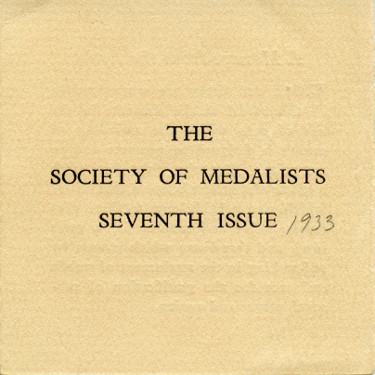
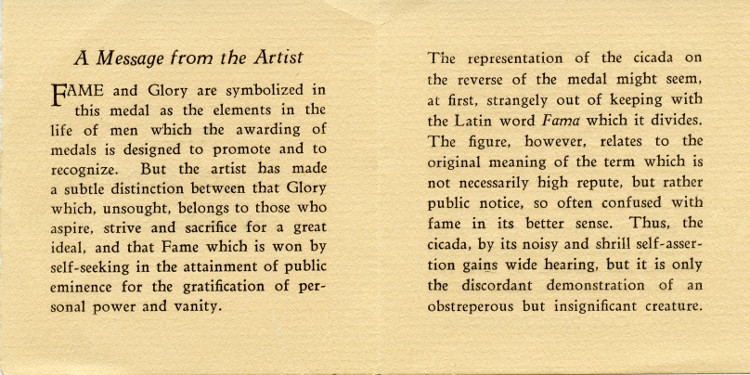
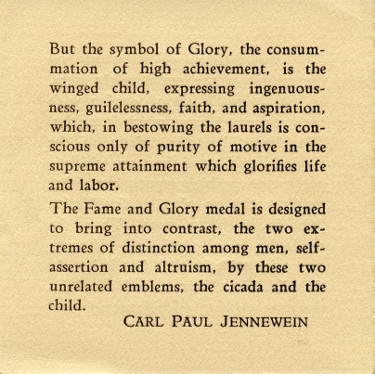
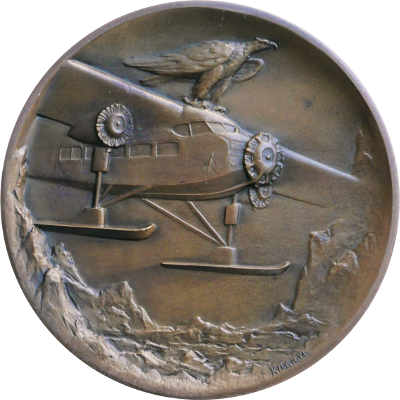
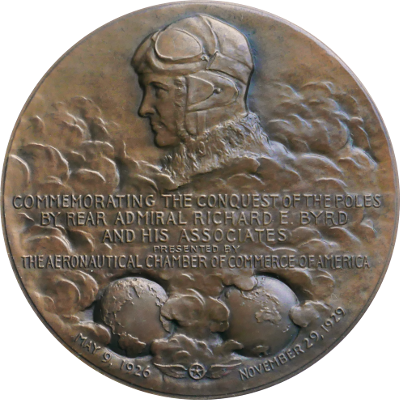
The obverse bears eagle perched on airborne Ford tri-motor; polar scene below, Signed at bottom right, KILENYI.
The reverse bears a bust (l.) of Richard Byrd wearing aviator's goggles emerging from a bank of clouds. Across, COMMEMORATING THE CONQUEST OF THE POLES / BY REAR ADMIRAL RICHARD E. BYRD / AND HIS ASSOCIATES / PRESENTED BY / THE AERONAUTICAL CHAMBER OF COMMERCE OF AMERICA; along bottom edge, MAY 9 1926 - NOVEMBER 29 1929.
The medal measures 82.6mm (3.25") in diameter and was manufactured by Whitehead & Hoag. During the presentation banquet one gold medal was given to Admiral Byrd, his associates received silver medals, and all other guests received bronze medals. The exact mintage is not reported.
References: Marqusee 217

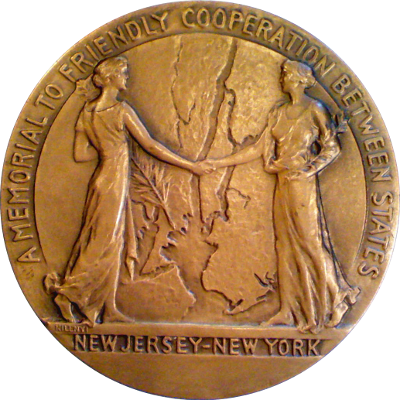
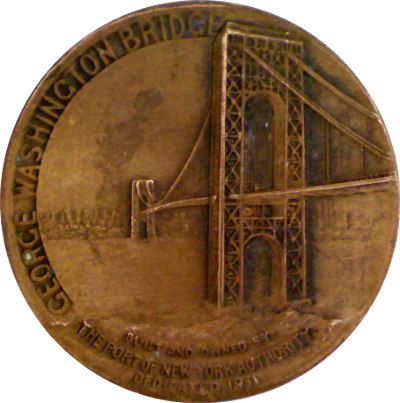
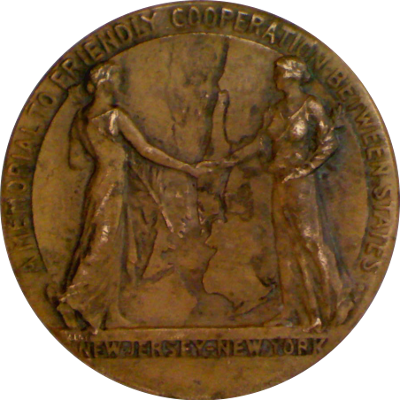
The obverse bears perspective of Hudson River suspension bridge. Around left and top, GEORGE WASHINGTON BRIDGE; below, BUILT AND OWNED BY / THE PORT OF NEW YORK AUTHORITY.
The reverse displays muses clasping hands over relief map of river and harbor. Around, A MEMORIAL TO FRIENDLY COOPERATION BETWEEN STATES; in exergue, NEW JERSEY - NEW YORK; signed at left top of exergue, KILENYI
In 1931, the Port Authority opened two major bridges, the George Washington Bridge on October 24th and the Bayonne Bridge on November 14th. The George Washington Bridge Dedication was a big affair commemorated with 2 gold medals, silver medals, bronze medals in 2 sizes, a hanging badge and a small round medal, represented here.
The dedication was a major political event. The Governor of New York, Franklin Delano Roosevelt, a man with serious Presidential aspirations, was one of the major participants in the ceremonies.
All variants were produced by the Whitehead & Hoag Company of Newark, New Jersey.


The obverse bears high-relief clothed portrait bust of Abraham Lincoln facing right. Lincoln quote above around: FOR FURTHER UNIFICATION OF THE PEOPLE. Signed at bottom left of bust: KILENYI.
The reverse depicts a perspective view in low-relief of the western tunnel portal in Weehawken, New Jersey, looking east with Manhattan in the background. Inscription in exergue: LINCOLN TUNNEL/ DEDICATED 1937/ BUILT AND OWNED BY/ THE PORT OF NEW YORK AUTHORITY.
Officially called the "Lincoln Tunnel Dedication Medal" on the ticket to the dedication, this 32mm gilt copper medal was originally distributed only to holders of tickets to the dedication ceremonies or luncheon on December 21, 1937. Ceremonies were held in both New York and in Weehawken, New Jersey. The two-part ticket, showing the obverse and reverse of the commemorative medal embossed in gold, had a perforated bottom that was removable and intended to be redeemed by the registered guest for their copy of the commemorative medal. A red printed serial number was printed on the back of both parts of the ticket.
The medal measures 32mm and was struck by the Whitehead & Hoag Company, New Jersey.

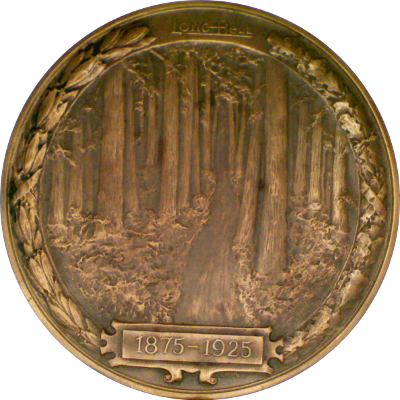
The obverse bears bust l. of Robert A. Long, founder of the Long-Bell Lumber Company. Around, THE LONG-BELL LUMBER COMPANY / FIFTIETH ANNIVERSARY; to left, ROBERT A. LONG / FOUNDER; to right, signed KILENYI.
The reverse bears image of path through forest, surrounded by laurel and oak leaves. Above, LONG-BELL; below in cartouche, 1875-1925.
The Long-Bell Lumber Company was started by Robert A. Long and Victor Bell. They had started out selling hay in Columbus, Ohio, but quickly discovered that the wood they needed to construct storage sheds and wagons was much more precious than their hay cargo, so they tore down the sheds and sold the lumber. In 1887 they officially incorporated the Long-Bell Lumber Company and grew it into a major business.
Their company was sold to International Paper in 1956.
Kilényi picked up the forest motif he had used on the reverse of this medal when he designed the reverse of the Fruit of the Loom medal in 1951.
The medal measures 83mm in diameter.
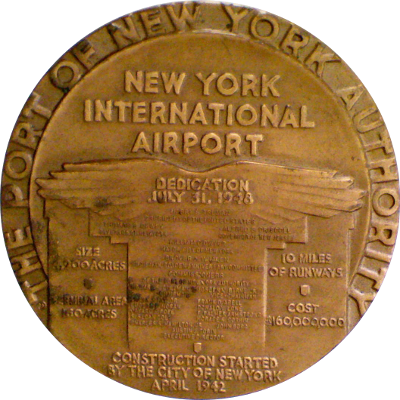
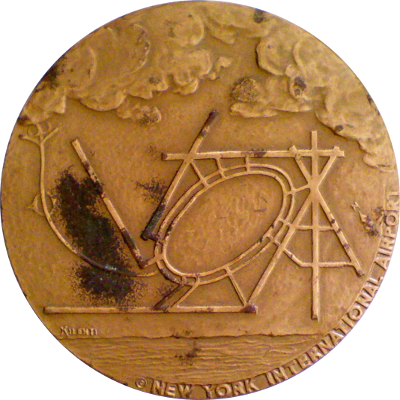
The medal's obverse bears a winged plaque and lots of lext. Around top, THE PORT OF NEW YORK AUTHORITY; at top of center, NEW YORK / INTERNATIONAL / AIRPORT; on plaque, DEDICATION / JULY 31, 1948, followed by long list of names and titles; plaque surrounded by airport statistics.
The medal's reverse bears an aireal view of runway layout with clouds at top and sea at bottom. Around bottom edge, © NEW YORK INTERNATIONAL AIRPORT; signed over shoreline at left, KILENYI
The edge is marked ROBBINS - GENUINE / BRONZE
New York International Airport, now known as John F. Kennedy airport, was built to relieve LaGuardia Airport which was overcrowded soon after opening in 1939. Construction began in 1943, and about $60 million was initially spent of governmental funding, but only 1,000 acres (400 ha) of land on the site of the Idlewild Golf Course were earmarked for use.
The project was renamed Major General Alexander E. Anderson Airport in 1943, after a Queens resident who had commanded a Federalized National Guard unit in the southern United States and died in late 1942. In March 1948 the New York City Council changed the name to New York International Airport, Anderson Field, but the common name was "Idlewild" until 1963.
The Port Authority leased the JFK property from the City of New York in 1947 and maintains this lease today. The first airline flight from JFK was on July 1, 1948; the opening ceremony was attended by then U.S. President Harry S. Truman. The Port Authority cancelled foreign airlines' permits to use LaGuardia, forcing them to move to JFK during the next couple of years.
This medal measures 76mm (3in) in diameter and was struck in bronze and silver by the Robbins Company of Attleboro, Massachusetts. A silver variant was part of the Marqusee collection.
References: Marqusee 226
All that being said, I've only seen this medal come up once in two years, so it seems to be on the rarer side. In good shape, I would estimate it to be worth $100 to $130.
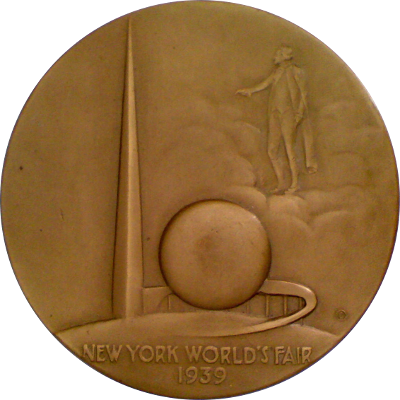
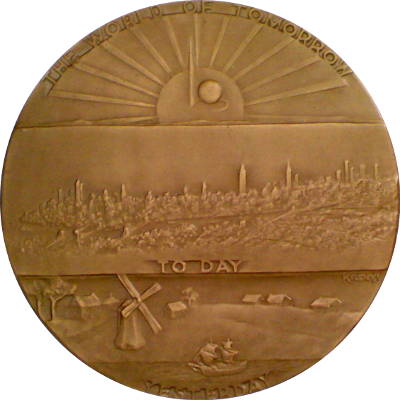
The obverse bears view of iconic Trylon and Perisphere; at upper right, a full length figure of George Washington emerges from cloud banks. At bottom, NEW YORK WORLD'S FAIR / 1939; at right, ©
The reverse bears three panels; top panel shows Trylon and Perisphere over radiant sun; above, THE WORLD OF TOMORROW; the middle panel shows view of Manhattan skyline as seen from the World's Fair grounds with legend TODAY; bottom panel shows view of New Amsterdam with legend YESTERDAY; signed at top right corner of bottom panel, KILENYI
The edge bears the marks ROBBINS CO. / ATTLEBORO - BRONZE.
This was the official medal of the New York World's Fair of 1939-40. The 190m-tall spire-shaped Trylon contained the (at the time) longest escalator and the 54m-diameter Perisphere housed a diorama called "Democracity" which depicted an topian city-of-the-future. A moving sidewalk transported spectators past the exhibits.
A much rarer version of the medal exists in which the year is 1940 rather than 1939.
The medal measures 63.5mm in diameter and was struck by the Robbins Company of Attleboro, Massachusetts.

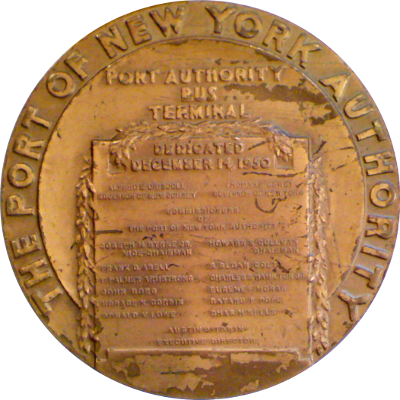
The obverse bears corner view of New York Port Authority Bus Terminal with billowing clouds above. Around, PORT AUTHORITY BUS TERMINAL; streets labeled, 41ST ST. and 8TH AVE.; below, TO SERVE THE PUBLIC; signed at bottom, KILENYI
The reverse bears garlanded tablet in center field. Around, THE PORT OF NEW YORK AUTHORITY; above tablet, PORT AUTHORITY / BUS / TERMINAL; on tablet, DEDICATED / DECEMBER 14, 1950; list of officials' names follows.
By 1939, growing interstate bus traffic was causing chaos in New York City. Buses would drive to and from eight separate bus terminals scattered throughout Midtown. Congestion was a major problem, and the City needed a good answer.
Mayor Fiorello LaGuardia appointed a committee of City officials to resolve the issue. The committee arrived at several solutions, which were quickly shot down by the City's smaller bus terminals. That's when the Mayor asked the Port Authority of New York and New Jersey, established in 1921, to promote and protect the commerce of the bistate region, to evaluate the concept of consolidating all smaller bus stations into one central terminal. Ground was broken on January 27, 1949, and on December 15, 1950, the new Bus Terminal was dedicated.
This medal measures 76mm in diameter and was struck in bronze by the Whitehead and Hoag Company of Newark, New Jersey.
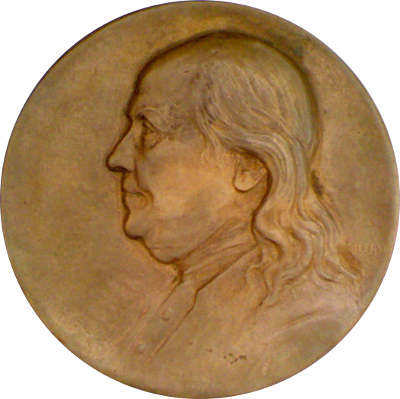
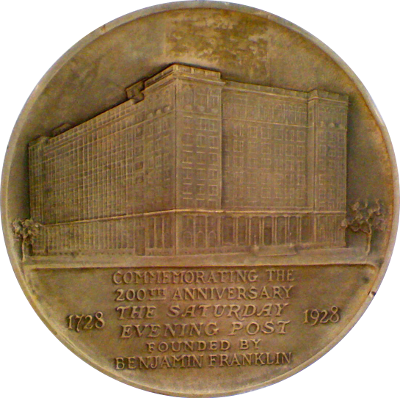
The obverse bears a mature bust of Franklin facing left. Signed at right, KILENYI.
The reverse bears image of corporate building. In exergue, COMMEMORATING THE / 200TH ANNIVERSARY / THE SATURDAY / EVENING POST / FOUNDED BY / BENJAMIN FRANKLIN; on left and right, 1728 - 1928.
The edge is marked WHITEHEAD-HOAG.
The medal measures 101mm in diameter and was struck by the Whitehead & Hoag Company of Newark, New Jersey.
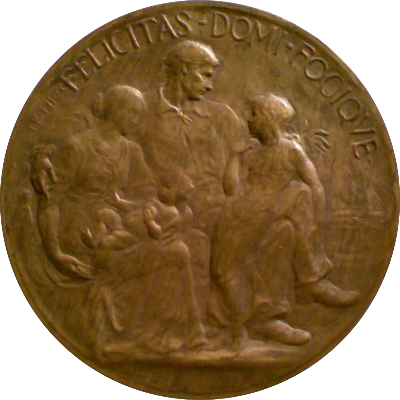
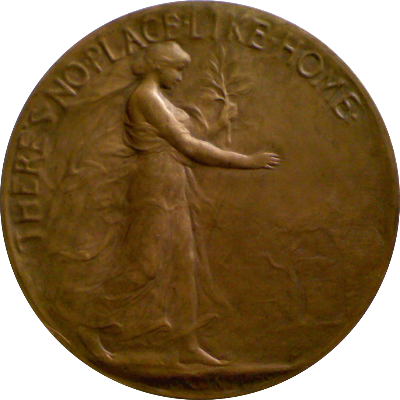
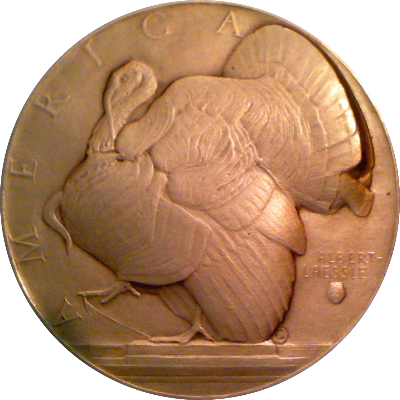
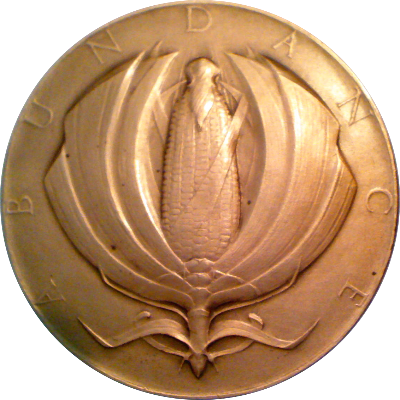
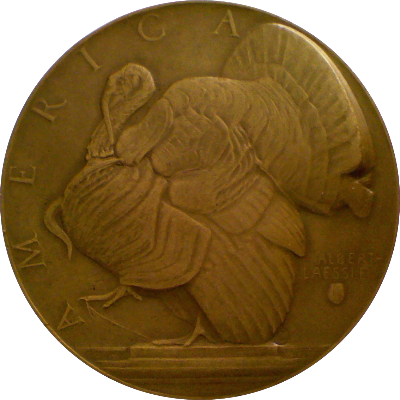

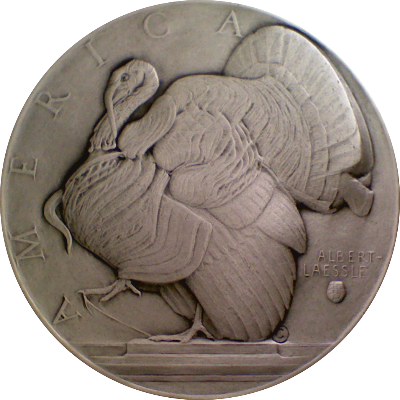
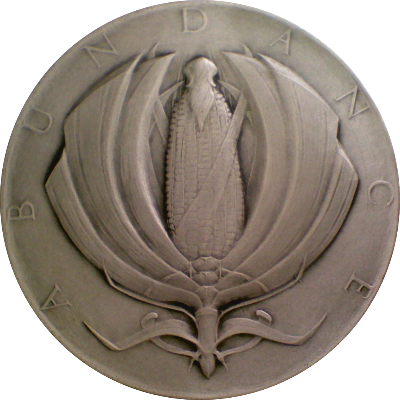
This medal was chosen as the 10th issue of the prestigious Society of Medalists series. The medal's obverse bears a strutting turkey cock and the legend AMERICA, with signature ALBERT - / LAESSLE. Turtle shell under signature. The reverse bears an ear of corn framed by separated husks. Around, ABUNDANCE.
Laessle said in the brochure that accompanied the medal:
"Wishing to symbolize the abundance of America, I have chosen for my medal two truly American subjects, the turkey and the corn."
It should be noted that America, like most other developed nations at the time, was still in the grip of the Great Depression when this medal was issued.
This medal measures 73mm in diameter and was produced by the Medallic Art Company of New York. The reported mintage for this issue is 1,021 in bronze, 125 in silver.
References: Marqusee 234
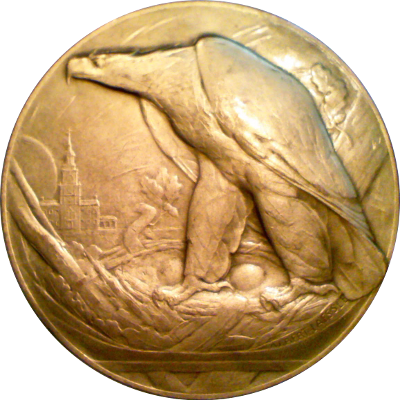
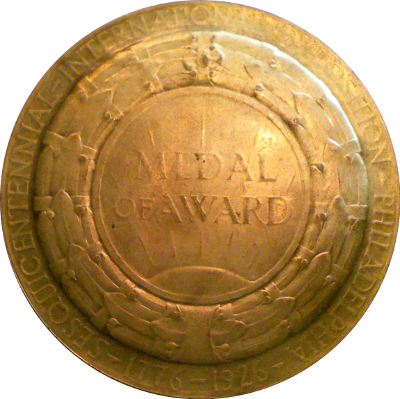
Leassle designed this medal for an exposition on his "home turf" in Philadelphia. The obverse bears an eagle standing guard over nest with two eggs in front of Independence Hall and rising sun. Signature ALBERT LAESSLE. The reverse bears a laurel wreath around central field with rising sun and legend MEDAL OF AWARD. Around, SESQUICENTENNIAL - INTERNATIONAL - EXPOSITION - PHILADELPHIA / 1776 - 1926.
The medal measures 76mm in diameter and was struck by Baily Banks & Biddle Co., Philadelphia.
Laessle himself won his design in gold at this exposition.
References: Marqusee 235
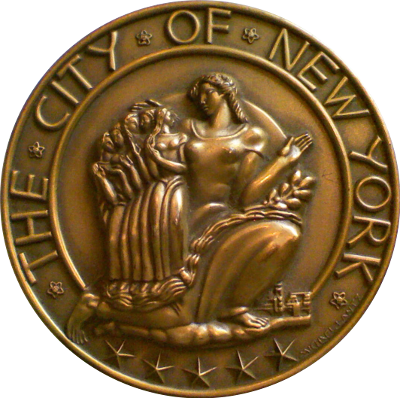
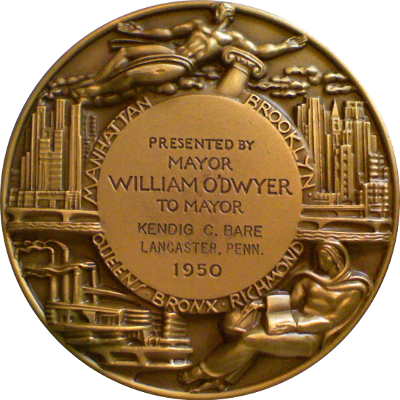
The obverse bears Art Deco style allegory depicting a kneeling female figure (representing the city) with five smaller figures (representing the five boroughs) standing on her extended leg. Around, THE CITY OF NEW YORK / * * * * *; signed along edge at 5:00 position: MICHAEL LANTZ.
The reverse bears flying male figure at top with skyscrapers below to either side; at bottom right, a reclining female figure holding book; at bottom left, a factory with smokestacks; at center, inscribed field surrounded by the names of the five boroughs: MANHATTAN BROOKLYN QUEENS BRONX RICHMOND. This piece contains inscription: PRESENTED BY / MAYOR / WILLIAM O'DWYER / TO MAYOR / KENDIG C. BARE / LANCASTER. PENN. / 1950
This medal is the highest award conferred upon civilians by the City of New York. The medal is presented by the Mayor to those individuals who have demonstrated, "exceptional citizenship and outstanding achievement."
The recipients come from a wide range of backgrounds, including ordinary citizens, foreign dignitaries, athletes, and film stars. The recipient of this particular piece was Kendig C. Bare, the mayor of Lancaster, Pennsylvania. He was mayor from 1950 to 1958 and served in the Korean War in 1950/1951. This particular piece seems to be one of the earliest because the medal was only designed in 1950. It is based on Michael Lantz's Golden Anniversary medal from 1948 and reworked into this design in 1950.
This medal measures 70mm in diameter and was struck in bronze by the Medallic Art Company of New York.
References: Marqusee 236
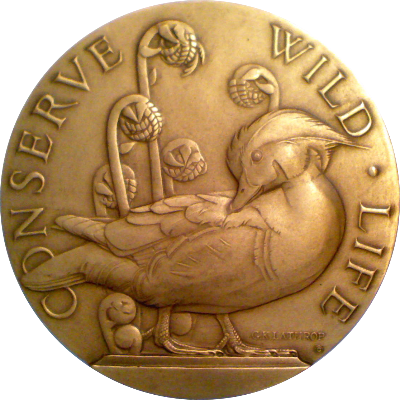
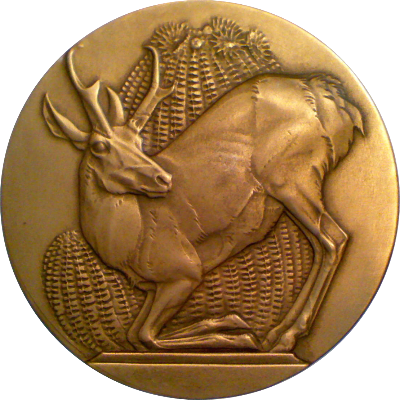
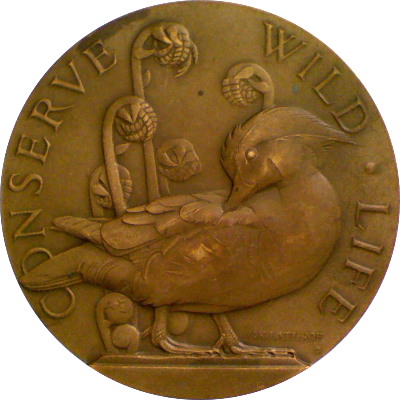
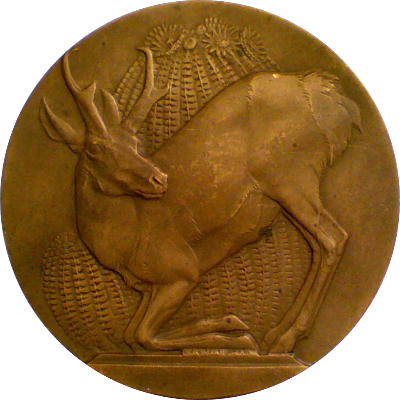
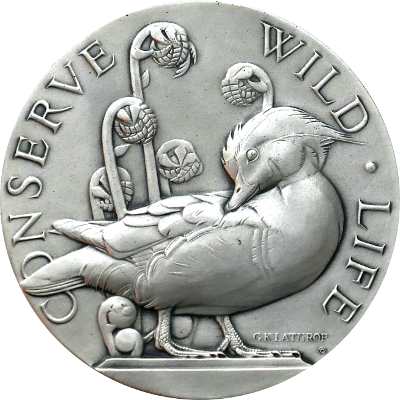
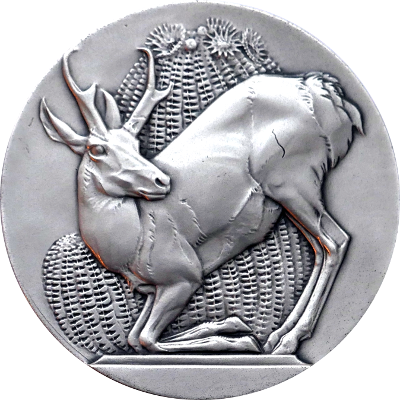
This medal was chosen as the 18th issue of the prestigious Society of Medalists series in 1938.
The obverse shows wood duck preening, new fern fronds uncurling in background. Around, CONSERVE WILD LIFE; in lower right, signed G.K.LATHROP / ©
The reverse bears a kneeling pronghorn with large barrel cactus behind.
Gertrude Lathrop was an early environmentalist. She was deeply concerned with preserving wilderness and wildlife and railed against inhumane traps, farmers who killed predators, the use of furs in fashion, indiscriminate use of poisons, and the slaughter of entire species of birds and animals.
She chose the wood duck because it was endangered by the draining of wetlands and the pronghorn because by 1938 the only exemplars to be found lived on reservations.
The medal measures 73mm in diameter and was struck by the Medallic Art Company of New York. Its reported mintage is 1,025 pieces in bronze and 100 in silver.
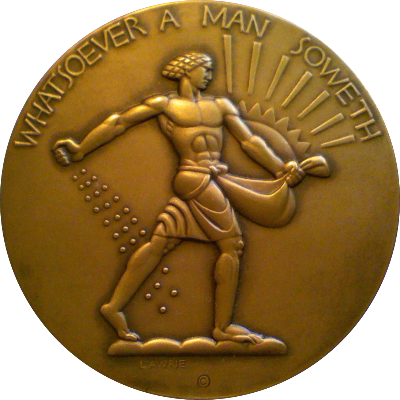
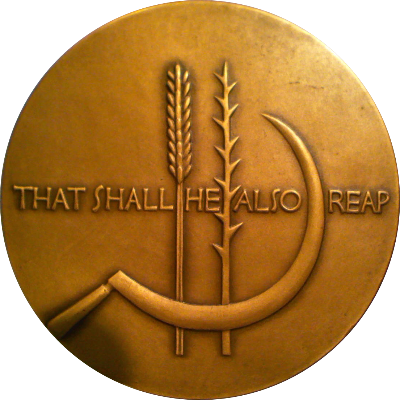
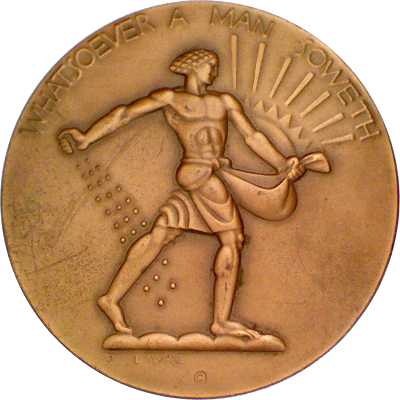
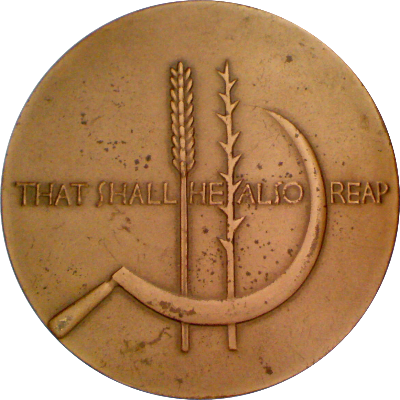
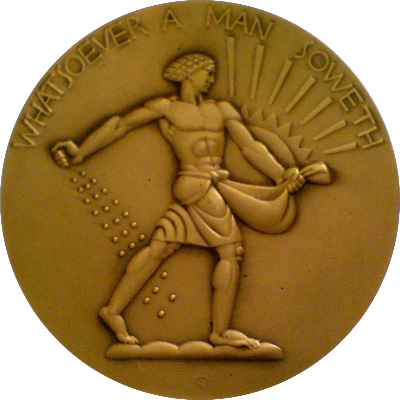
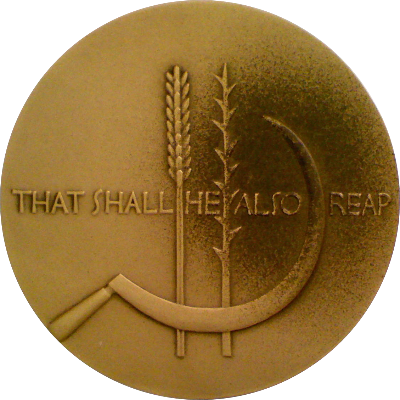
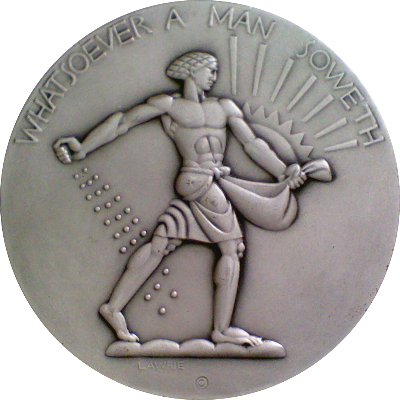

This medal was chosen as the fifth issue of the prestigious Society of Medalists series in 1932. The obverse bears a sower scattering seeds under a stylized sun. Above, WHATSOEVER A MAN SOWETH; in exergue, LAWRIE / © The reverse bears a sickle poised over a wheat ear and a nettle. Across, THAT SHALL HE ALSO REAP
Lee Lawrie was fascinated by the sower and reused this motif time and again in many projects. Originally conceived for the Nebraska State Capital, where it adorns the dome in the form of a giant statue, he also used it on the Rockefeller Center in New York. In the artist's own words:
"All of us are sowers, and we should not expect life to yield much in return for little, or little for nothing, or anything at all for the mere wishing - either in a material or in a higher, abstract way."
The medal measures 73mm in diameter and was struck by the Medallic Art Company of New York. The reported production quantity is 1,617 in bronze and 35 in silver.
References: Marqusee 241
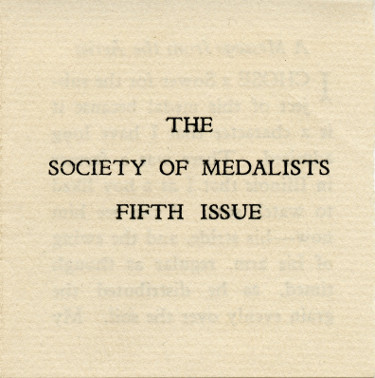
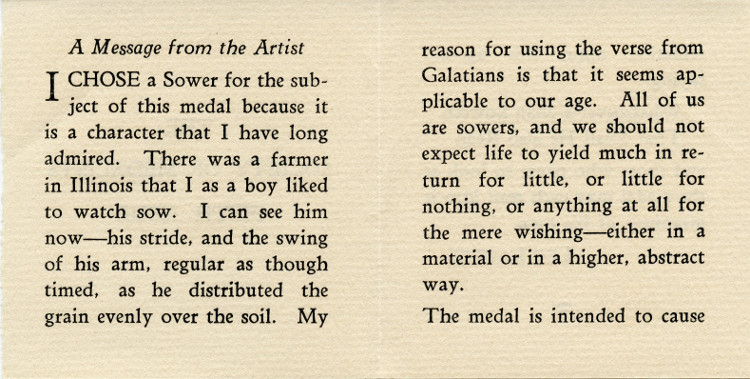
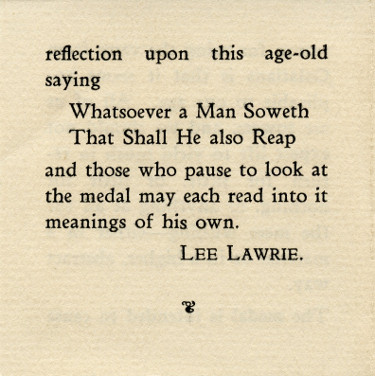
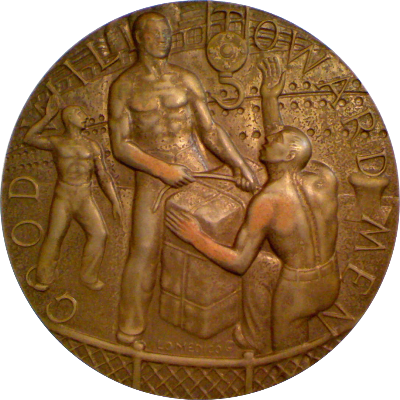
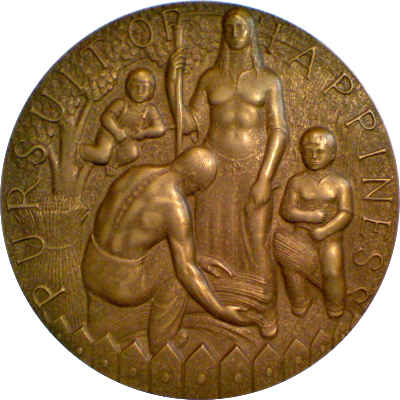
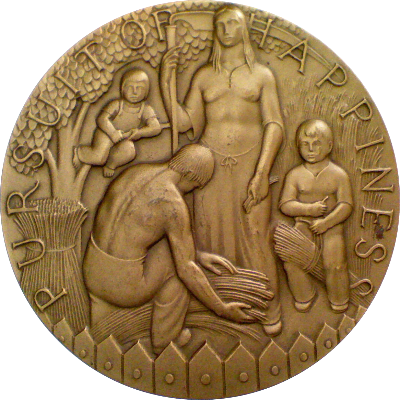
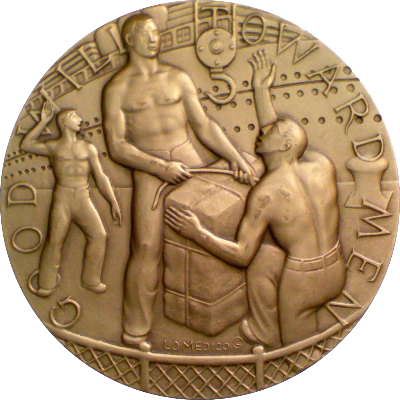
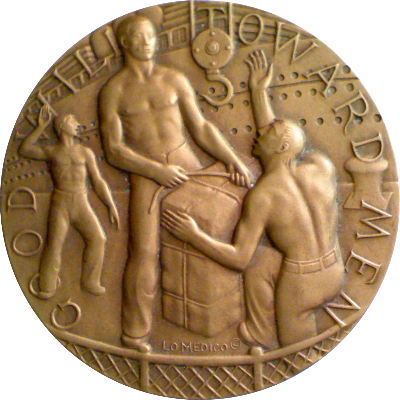
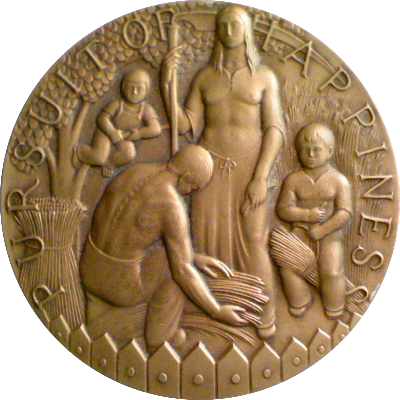
This medal was chosen as the 38th issue of the prestigious Society of Medalists series in 1948. The obverse bears a farming family working at harvest time. Around, PURSUIT OF HAPPINESS. The reverse bears shirtless stevedores loading ship. Around, GOOD WILL TOWARD MEN; below LO MEDICO ©.
The brochure which acommpanied the medal had the following words from the artist:
"From time immemorial man's behavior has been motivated by two major objectives. One is his desire to gather the fruits of his labor in peace, dignity and freedom. The other has been to establish a bond of kinship between himself and his fellow man."
The medal measures 73mm in diameter and was produced by the Medallic Art Company of New York. Its reported production quantity is 727 pieces in bronze and 50 in silver.
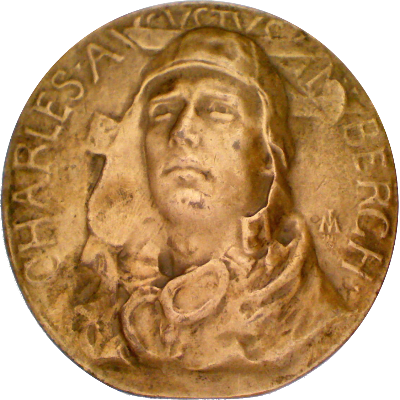
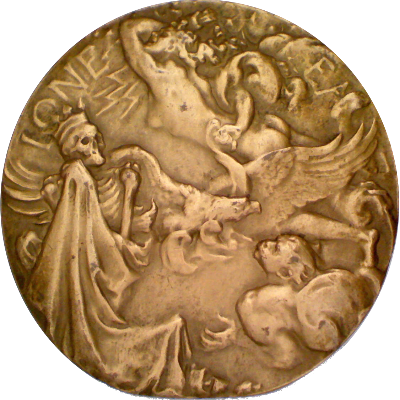
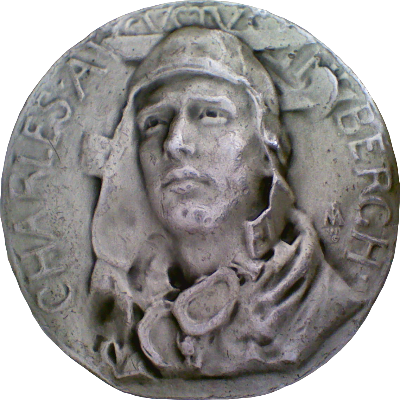
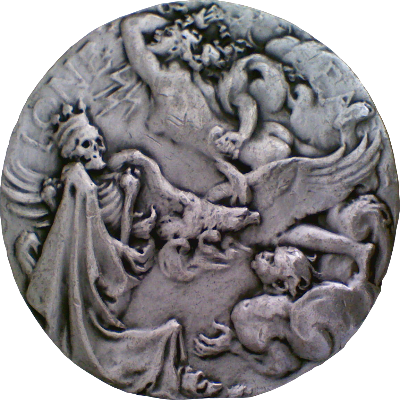
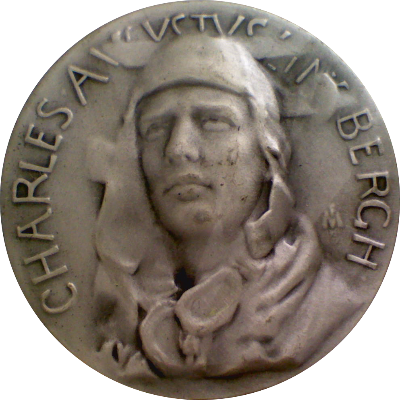
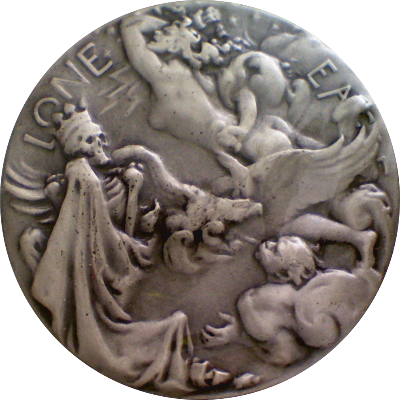
This medal was chosen as the fourth issue of the prestigious Society of Medalists series in 1931. The obverse bears a likeness of Charles Lindbergh wearing flight gear, goggles dangling over his chest, with the inscription "CHARLES AUGUSTUS LINDBERGH" and Frederick MacMonnies' monogram FM / 1931 / ©
The reverse bears an allegorical scene together with the inscription "LONE EAGLE."
Lindbergh's non-stop transatlantic flight from Long Island to Paris took place between May 20th and 21st 1927. Not only did he win $25,000 in prize money for the first non-stop flight from New York to Paris, he also captivated the imagination of an entire generation. Upon his arrival at the airfield of Le Bourget, just outside of Paris, a 100,000 strong crowd gave him a hero's welcome. His achievement was commemorated in countless stamps, medals, and commemorative issues of all kinds.
MacMonnies created this medal four years after the flight and late in his career. He tried to convey Lindbergh' spirit
and courage on the obverse.  In MacMonnies' own words:
In MacMonnies' own words:
"To attempt to commemorate Lindbergh's mighty achievement within the tiny compass of a three inch medal is preposterous, and if one does not succeed in represeting even a faint suggestion if the sublime courage that faced appaling odds - the fascinating problem is compensation enough. In the head of Lindbergh I have tried to catch something of the inner belief and nobility of vision of the boy, together with the experience of the master airman."
MacMonnies likely based his obverse design on the iconic photo of Lindbergh shown here.
Struck by the Medallic Art Company of New York, this medal measures 73mm in diameter. The reported production quantity is 1,989 in bronze and 250 in silver though there were two additional 32mm-diameter editions in bronze and silver.
References: Marqusee 249
